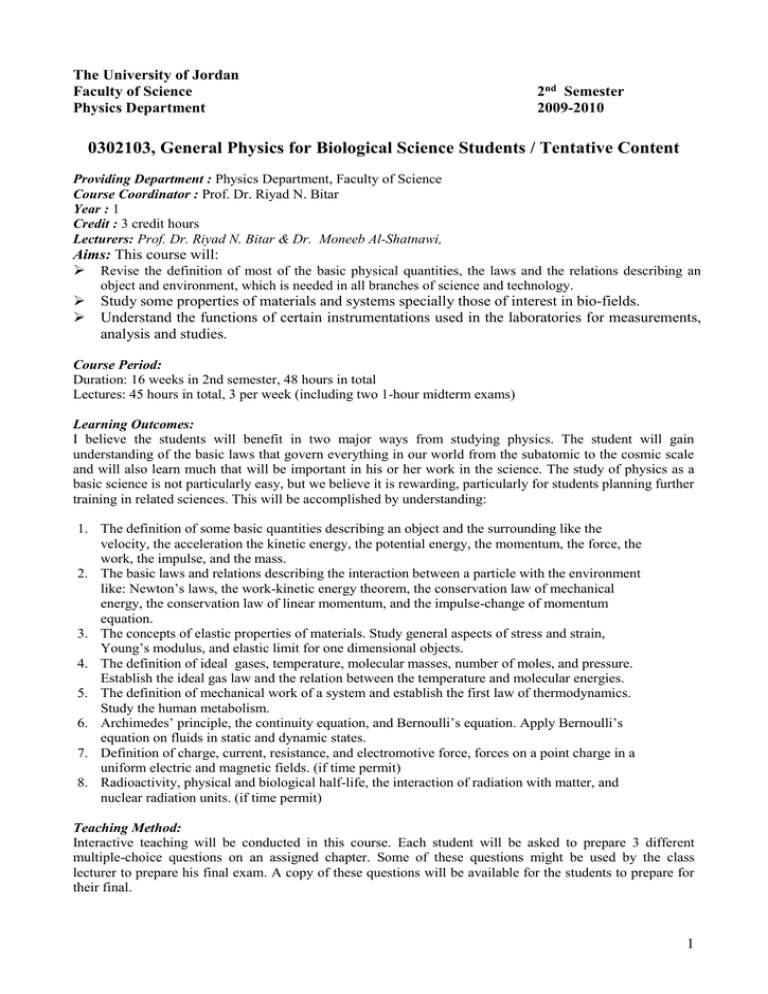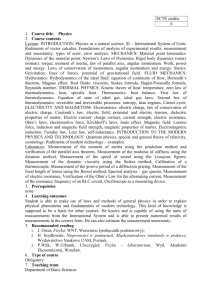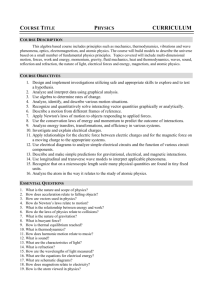103-Syl - The University of Jordan
advertisement

The University of Jordan Faculty of Science Physics Department 2nd Semester 2009-2010 0302103, General Physics for Biological Science Students / Tentative Content Providing Department : Physics Department, Faculty of Science Course Coordinator : Prof. Dr. Riyad N. Bitar Year : 1 Credit : 3 credit hours Lecturers: Prof. Dr. Riyad N. Bitar & Dr. Moneeb Al-Shatnawi, Aims: This course will: Revise the definition of most of the basic physical quantities, the laws and the relations describing an object and environment, which is needed in all branches of science and technology. Study some properties of materials and systems specially those of interest in bio-fields. Understand the functions of certain instrumentations used in the laboratories for measurements, analysis and studies. Course Period: Duration: 16 weeks in 2nd semester, 48 hours in total Lectures: 45 hours in total, 3 per week (including two 1-hour midterm exams) Learning Outcomes: I believe the students will benefit in two major ways from studying physics. The student will gain understanding of the basic laws that govern everything in our world from the subatomic to the cosmic scale and will also learn much that will be important in his or her work in the science. The study of physics as a basic science is not particularly easy, but we believe it is rewarding, particularly for students planning further training in related sciences. This will be accomplished by understanding: 1. The definition of some basic quantities describing an object and the surrounding like the velocity, the acceleration the kinetic energy, the potential energy, the momentum, the force, the work, the impulse, and the mass. 2. The basic laws and relations describing the interaction between a particle with the environment like: Newton’s laws, the work-kinetic energy theorem, the conservation law of mechanical energy, the conservation law of linear momentum, and the impulse-change of momentum equation. 3. The concepts of elastic properties of materials. Study general aspects of stress and strain, Young’s modulus, and elastic limit for one dimensional objects. 4. The definition of ideal gases, temperature, molecular masses, number of moles, and pressure. Establish the ideal gas law and the relation between the temperature and molecular energies. 5. The definition of mechanical work of a system and establish the first law of thermodynamics. Study the human metabolism. 6. Archimedes’ principle, the continuity equation, and Bernoulli’s equation. Apply Bernoulli’s equation on fluids in static and dynamic states. 7. Definition of charge, current, resistance, and electromotive force, forces on a point charge in a uniform electric and magnetic fields. (if time permit) 8. Radioactivity, physical and biological half-life, the interaction of radiation with matter, and nuclear radiation units. (if time permit) Teaching Method: Interactive teaching will be conducted in this course. Each student will be asked to prepare 3 different multiple-choice questions on an assigned chapter. Some of these questions might be used by the class lecturer to prepare his final exam. A copy of these questions will be available for the students to prepare for their final. 1 Assessment of Learning Outcomes All learning outcomes are assessed by two tests during the semester, course activity, and final examination. Mode of Assessment: Two 1-hour midterm exams (20% each); Course activity (10%); 2-hour final examination (50%) Syllabus: Revision : 1. Definition of Physical Quantities Describing a particle: Position, velocity, mass, Kinetic energy, potential energy, mechanical energy, and linear and angular momentum. [7 hours]. 2. Definition of Physical Quantities Describing Interaction (environment): Force, work done by a force, impulse of a force, and power done by a force. [6 hours]. 3. Laws and Relations Connecting the Change in Object Varibles with Interaction: Newton’s Laws, work-kinetic energy theorem, impulse-change of linear momentum equation, conservation law of mechanical energy, conservation law of linear momentum. [7 hours]. The Mechanics of Nonviscous Fluids: Archimedes’ principle, the continuity equation, Bernoulli’s equation, static and dynamic consequence of Bernoulli’s equation. [6 hours] Elastic Properties of Materials: General aspects of stress and strain, Young’s modulus, elastic limit, some applications [2 hours]. Thermal Behaviour and Equation of State of Ideal Gases: Definition of temperature, molecular masses, number of moles, and pressure, the ideal gas law, gas mixtures, temperature and molecular energies [7 hours]. Thermodynamics: Mechanical work, basic definitions of thermodynamic processes, the first law of thermodynamics, Human metabolism [5 hours]. Some Electric Properties of matter: Definition of charge, current, resistance, current and electromotive force, forces on a point charge in a uniform electric and magnetic fields. [5 hours]. Nuclear radiation and its Interaction with matter: Radioactivity, physical and biological halflife, the interaction of radiation with matter, radiation units. [6 hours]. Textbooks Chris Vuille, Raymond A. Serway and Jerry S. Faughan, College Physics, Eight edition, Brooks/Cole, 2009. (ISBN-13: 978-0-495-55498-1). Course Time Table: Week 1, 2 & 3 3, 4 & 5 5 Chapter 2&3 Subject Définitions of physical quantities describing a particle 4 2, 3, 4, & 5 5&6 Définitions of physical quantities describing interaction 9 Elastic properties of materials and the Mechanics of 6, 7 & 8 1st Exam laws and relations connecting the change in object variables with interaction Nonviscous Fluids 8, 9 & 10 10 5, 6 &9 11, 12, 13 & 14 10, 11 &12 2nd Exam Thermal behaviour and equation of state of ideal gases and thermodynamics 15, 16, 17, 18 & 19 Electricity and Magnetism 15 & 16 Nuclear radiation and its Interaction with matter ???? 26 &29 2 Attendance Policy: Lecture attendance is required. The course notes and the textbook are comprehensive but additional material will be covered in lectures. You are responsible for the material covered in lectures. Expected Workload: On an average, you should expect to spend about 9 hours per week on this module. Important Dates: Two midterm exams will be announced in due time Final Exam: announced by the admission and registration office, please always check! Feedback: Concerns or complaints should be expressed in the first instance to the course lecturer. At the end of the course, the students will fill a course evaluation form, evaluating the content of the course, its teaching, the learning, and assessment methods, and the lecturer. The monitoring of these students feedback will allow the course quality improvement. Supporting Material: The text book does not cover exactly the material in this course in details. It is useful for a short and quick review of the material and for practicing on a short problems and questions solving. Therefore; for a more detailed material, discussions and improvements of your study on the course, please refer to the following supporting references: 1- Joseph W. Kane and Morton M. Sternheim Physics ,Third edition, John Wiley & Sons, 1988. 2- Raymond A. Serway, Physics for Scientists and Engineers, 4th edition, Saunders Golden Sunburst Series, 1990. 3- D. Halliday and R. Resnick Fundamentals of Physics, 10th edition , 1991. 4- H. D. Young and R. A. Freedman University Physics, 9th edition, Addison – Wesley, 1996. (ISBN:0-201-57157-9). 5- F. Sears, M. Zemansky and H. Young University Physics, 7th edition, 1987 . 6- H. D. Young, R. A. Freedman, T. R. Sandin, And A. Lewis Ford, Sears and Zemansky’s University Physics, 10th edition, 2000. (ISBN: 0-201-60322-5). 7- . 1990 , أالردن, دار أالمل – أربد, 2 طـ, الكهرباء والمغناطيسية, عبد السالم غيث. محمـود الكوفحي و د. د Instructors: Name Office Number Office Phone E-mails Office hours Prof. Dr. Riyad N. Bitar, Dr. Moneeb Al-Shatnawi 309, 204 Ext. 22044, 22064 riyadnb@ju.edu.jo for Prof. Bitar and moneeb.shatnawi@ju.edu.jo for Dr. Shatnawi For Dr Shatnawi: 10:30 – 11:30 S, T an Thur For Prof. Bitar: 1:00 -2:00 S, T, Thur. 3







